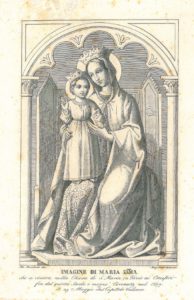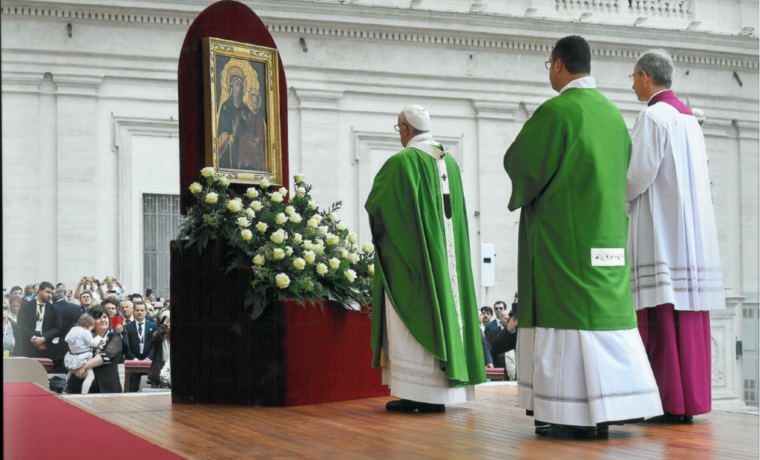 Riccarda Lazzari, Maria nel mondo della salute, San Paolo, Cinisello Balsamo (Milan), 2010, 303pp.
Riccarda Lazzari, Maria nel mondo della salute, San Paolo, Cinisello Balsamo (Milan), 2010, 303pp.
16 November – Feast Day of Our Lady of Health
‘The witnesses of the Cross and Resurrection of Christ’, observed Salvifici Doloris (n. 25), ‘have handed on to the Church and to mankind a specific Gospel of suffering. The Redeemer himself wrote this Gospel, above all by his own suffering accepted in love, so that man “should not perish but have eternal life” (Jn 3:16)’. But at the side of Jesus, ‘in the first and most exalted place’, there is his Most Holy Mother, who by her whole life bore exemplary testimony ‘to this particular Gospel of suffering’. The same document rightly affirms: ‘As a witness to her Son’s Passion by her presence, and as a sharer in it by her compassion, Mary offered a unique contribution to the Gospel of suffering, by embodying in anticipation the expression of Saint Paul which was quoted at the beginning. She truly has a special title to be able to claim that she “completes in her flesh” – as already in her heart – “what is lacking in Christ’s afflictions”’.
Because of this strong experience of pain endured by the Most Holy Virgin in the economy of Salvation, the sick and the suffering of all ages have seen in the Mother of the Lord and the Church an icon to contemplate, a model to be lived, but also a mother to whom to address prayers for healing, to obtain comfort in pain, and to receive courage and hope in the drama of illness and death.
The prayer of the Litany which defines Mary as the ‘health of the sick’ has its theological foundation in the economy of Salvation and more specifically in the context of Salvation-health, where Mary plays an important role.
This invocation is also much used in the world of popular piety.
‘Mary was called to cooperate with the redemptive plan of God, and as a consequence was appointed by God to distribute the fruits of the redemption itself. The Virgin who cooperated with Christ to regain man’s health is always called to provide the same health, which is spiritual holiness but also psycho-physical existential holiness’. The charism of healing infirmity stands out in Mary specifically because in her the perfection that the Lord asks from his Church has already been achieved. The whole of tradition and the Magisterium itself affirm the ‘Church’s consciousness’ of this. From the most ancient Marian inscriptions to the long literature that celebrates the role and the maternal presence of Mary in the life of the Church, prayers to the Virgin to obtain physical and spiritual health from her son Jesus are constant.
The Magisterium, in particular, from the origins of the Church until our own times, has always seen Mary as interceding with her Son for all of her children. Over the last two centuries meditation on Mary, ‘health of the sick’, has been a constant theme of the documents of the Supreme Pontiffs – Pius IX, Leo XIII, Pius X, Benedict XV, Pius XI – and was translated into a choral celebration in the vast Marian production of Pius XII, the Supreme Pontiff who proclaimed the Assumption of the Virgin into heaven, of Paul VI, and of John Paul II.
The Second Vatican Council itself declared: ‘By her maternal charity, she cares for the brethren of her Son, who still journey on earth surrounded by dangers and cultics, until they are led into the happiness of their true home. Therefore the Blessed Virgin is invoked by the Church under the titles of Advocate, Auxiliatrix, Adjutrix, and Mediatrix’. Paul VI, when ending the deliberations of the Second Vatican Council, defined Mary as the ‘Mother of the Church’ and in his Marialis Cultus he described in an incisive way the maternal role of Mary at the side of the sick and suffering of today’s world: ‘Contemplated in the episodes of the Gospels and in the reality which she already possesses in the City of God, the Blessed Virgin Mary offers a calm vision and a reassuring word to modern man, torn as he often is between anguish and hope, defeated by the sense of his own limitations and assailed by limitless aspirations, troubled in his mind and divided in his heart, uncertain before the riddle of death, oppressed by loneliness while yearning for fellowship, a prey to boredom and disgust. She shows forth the victory of hope over anguish, of fellowship over solitude, of peace over anxiety, of joy and beauty over boredom and disgust, of eternal visions over earthly ones, of life over death’.















Camillians on Facebook
Camillians on Twitter
Camillians on Instagram